How Does the Pilot Information Consumption Policy Affect Urban Carbon Productivity? Quasi-Experimental Evidence from 275 Chinese Cities
Abstract
1. Introduction
1.1. Introduction
1.1.1. Definition of Research
1.1.2. Research Perspective
1.1.3. Research Objectives
1.2. Research Hypotheses
2. Materials and Methods
2.1. Model Specification
2.1.1. Multi-Period Difference-in-Differences Model
2.1.2. Density Estimation
2.1.3. Mediation Effect Model
2.1.4. Spatial Heterogeneity Model
2.2. Variable Selection
2.2.1. Dependent Variable
2.2.2. Control Variables
2.2.3. Mediator Variables
2.2.4. Data Sources
3. Results
3.1. Carbon Productivity Trends over Time
3.2. Carbon Productivity Kernel Density Analysis
3.3. Benchmark Regression Results
3.4. Identification Condition Test
3.5. Placebo Test
3.6. Robustness Tests
3.7. Heterogeneity Analysis
3.8. Impact Mechanism Test
4. Discussion
5. Conclusions
5.1. Conclusions
5.2. Recommendations
Author Contributions
Funding
Institutional Review Board Statement
Informed Consent Statement
Data Availability Statement
Conflicts of Interest
References
- Liu, X.; Luo, Y.; Guo, S.; Yang, X.; Chen, S. Information consumption city and carbon emission efficiency: Evidence from China’s quasi-natural experiment. Environ. Res. 2024, 255, 119182. [Google Scholar] [CrossRef]
- Liu, L.; Chen, M.; Wang, H.; Liu, B. How does the Chinese pilot policy on information consumption affect carbon emissions? Sustain. Prod. Consum. 2023, 41, 88–106. [Google Scholar] [CrossRef]
- Zhang, K.; Zhu, P.-H.; Qian, X.-Y. National information consumption demonstration city construction and urban green development: A quasi-experiment from Chinese cities. Energy Econ. 2024, 130, 107313. [Google Scholar] [CrossRef]
- Huang, X.-X.; Hu, Z.-P.; Liu, C.-S.; Yu, D.-J.; Yu, L.-F. The relationships between regulatory and customer pressure, green organizational responses, and green innovation performance. J. Clean. Prod. 2016, 112, 3423–3433. [Google Scholar] [CrossRef]
- Xia, W.; Ruan, Z.; Ma, S.; Zhao, J.; Yan, J. Can the digital economy enhance carbon emission efficiency? Evidence from 269 cities in China. Int. Rev. Econ. Financ. 2025, 97, 103815. [Google Scholar] [CrossRef]
- Cui, X.; Li, P. Digital economy, environmental expenditure, and green total factor productivity. Finance Res. Lett. 2024, 73, 106624. [Google Scholar] [CrossRef]
- Jiang, T. Mediation and Moderation Effects in Empirical Research on Causal Inference. China Ind. Econ. 2022, 5, 100–120. [Google Scholar] [CrossRef]
- Li, X.; Xu, Y.; Tan, H.; Lei, Y. Low-carbon city pilot policies and urban carbon productivity improvement: An empirical analysis from the perspective of green competitiveness. Environ. Sustain. Indic. 2024, 24, 100531. [Google Scholar] [CrossRef]
- Lin, B.; Zhou, Y. Does the Internet development affect energy and carbon emission performance? Sustain. Prod. Consum. 2021, 28, 1–10. [Google Scholar] [CrossRef]
- La Ferrara, E.; Chong, A.; Duryea, S. Soap operas and fertility: Evidence from Brazil. Am. Econ. J. Appl. Econ. 2012, 4, 1–31. [Google Scholar] [CrossRef]
- Cohen, L.; Gurun, U.G.; Nguyen, Q.H. The ESG-Innovation Disconnect: Evidence from Green Patenting (NBER Working Paper No. 27990); National Bureau of Economic Research: Cambridge, MA, USA, 2020; Available online: https://www.nber.org/papers/w27990 (accessed on 29 March 2025).
- Wang, J.; Yu, S.; Li, M.; Cheng, Y.; Wang, C. Study of the impact of industrial restructuring on the spatial and temporal evolution of carbon emission intensity in Chinese provinces—Analysis of Mediating Effects Based on Technological Innovation. Int. J. Environ. Res. Public Health 2022, 14, 13401. [Google Scholar] [CrossRef] [PubMed]
- Coufal, D. Convergence rates of kernel density estimates in particle filtering. Stat. Probab. Lett. 2019, 153, 164–170. [Google Scholar] [CrossRef]
- Stief, A.; Baranowski, J. Fault diagnosis using interpolated kernel density estimate. Measurement 2021, 176, 109230. [Google Scholar] [CrossRef]
- Du, K.; Li, J. Towards a green world: How do green technology innovations affect total-factor carbon productivity. Energy Policy 2019, 131, 240–250. [Google Scholar] [CrossRef]
- Chen, Y.; Tian, W.; Ma, W.; Gu, J.; Ma, Z. Spatiotemporal Differentiation and Influencing Factors of Coordination Degree be-tween Population Urbanization and Land Urbanization Based on ESDA-GWR: A Case Study of the Central Plains Urban Agglomeration. Agric. Resour. Reg. China 2020, 41, 88–99. [Google Scholar]
- Wu, J.X.; Guo, Z.Y. Analysis of China’s Carbon Emission Convergence Based on Continuous Dynamic Distribution Method. Stat. Res. 2016, 33, 54–60. [Google Scholar] [CrossRef]
- GB/T 15317-2009; Energy Conservation Monitoring of Coal-Fired Industrial Boilers. China Standard Press: Beijing, China, 2009.
- Färe, R.; Grosskopf, S.; Pasurka, C.A. Environmental production functions and environmental directional distance functions. Energy 2007, 32, 1055–1066. [Google Scholar] [CrossRef]
- Andersen, P.; Petersen, N.C. A Procedure for ranking efficient units in data envelopment analysis. Manag. Sci. 1993, 39, 1261–1264. [Google Scholar] [CrossRef]
- Zhang, J.; Wu, G.; Zhang, J. Estimation of Interprovincial Physical Capital Stock in China: 1952–2000. Econ. Res. J. 2004, 10, 35–44. [Google Scholar]
- Zhao, J.; Yan, J. The impact of public fiscal expenditure on industrial transformation and upgrading: An inverted U-shape evidence from China. Heliyon 2024, 10, e38456. [Google Scholar] [CrossRef] [PubMed]
- Sharma, V.; Adil, M.H.; Fatima, S. Revisiting fiscal deficit sustainability and revenue-expenditure nexus in India. Dev. Sustain. Econ. Finance 2024, 2–4, 100020. [Google Scholar] [CrossRef]
- Guan, X.-G.; Ren, F.-R.; Fan, G.; Zhang, Q.-Q.; Wu, T.-F. Dynamic evaluation and sensitivity analysis of China’s industrial solid waste management efficiency based on ecological environment cycle perspective. Front. Environ. Sci. 2024, 12, 1462975. [Google Scholar] [CrossRef]
- Zhao, J.; Chen, W.; Liu, Z.; Liu, W.; Li, K.; Zhang, B.; Zhang, Y.; Yu, L.; Sakai, T. Urban expansion, economic development, and carbon emissions: Trends, patterns, and decoupling in mainland China’s provincial capitals (1985–2020). Ecol. Indic. 2024, 169, 112777. [Google Scholar] [CrossRef]
- Fankhauser, S.; Jotzo, F. Economic growth and development with low-carbon energy. WIREs Clim. Change 2017, 9, e495. [Google Scholar] [CrossRef]
- Qin, S.; Deng, H.; Hu, S. Digital development and China–BRICS trade: Role of institutional distance. Financ. Res. Lett. 2024, 73, 106636. [Google Scholar] [CrossRef]
- Deng, G.; Wu, Y.; Qian, J. Research on the impact of dual pilot projects for low-carbon and innovative cities on carbon emission efficiency. Front. Environ. Sci. 2024, 12, 1432400. [Google Scholar] [CrossRef]
- Wang, X.; Bu, L. International Export Trade and Enterprise Innovation: A Quasi-Natural Experiment Based on the Opening of the China-Europe Railway Express. China Ind. Econ. 2019, 10, 80–98. [Google Scholar]
- Liao, B.; Yang, Z.; Tian, C. Can information consumption promote the synergistic effect of urban pollution reduction and carbon emission reduction? Consum. Econ. 2025, 41, 45–58. [Google Scholar]
- Dabla-Norris, E.; Khalid, S.; Magistretti, G.; Sollaci, A. Does information change public support for climate mitigation policies? Clim. Policy 2024, 24, 1474–1487. [Google Scholar] [CrossRef]
- Wei, J.; Chen, H.; Long, R.; Zhang, L.; Feng, Q. Maturity of residents’ low-carbon consumption and information intervention policy. J. Clean. Prod. 2020, 277, 124080. [Google Scholar] [CrossRef]
- Cao, S.; Nie, L.; Sun, H.; Sun, W.; Taghizadeh-Hesary, F. Digital finance, green technological innovation and energy-environmental performance: Evidence from China’s regional economies. J. Clean. Prod. 2021, 327, 129458. [Google Scholar] [CrossRef]
- McKinsey Global Institute. The Carbon Productivity Challenge: Curbing Climate Change and Sustaining Economic Growth; McKinsey & Company: London, UK, 2008; Available online: https://www.mckinsey.com/mgi/overview (accessed on 29 March 2025).
- Zhou, P.; Ang, B.; Han, J. Total factor carbon emission performance: A Malmquist index analysis. Energy Econ. 2010, 32, 194–201. [Google Scholar] [CrossRef]
- Li, J.; Qu, S.; Peng, Z.; Ji, Y.; Boamah, V. The impact of green finance on carbon productivity: The mediating effects of the quantity and quality of green innovation. J. Environ. Manag. 2024, 370, 122952. [Google Scholar] [CrossRef] [PubMed]
- Sedjo, R.A.; Marland, G. Inter-trading permanent emissions credits and rented temporary carbon emissions offsets: Some issues and alternatives. Clim. Policy 2003, 3, 435–444. [Google Scholar] [CrossRef]
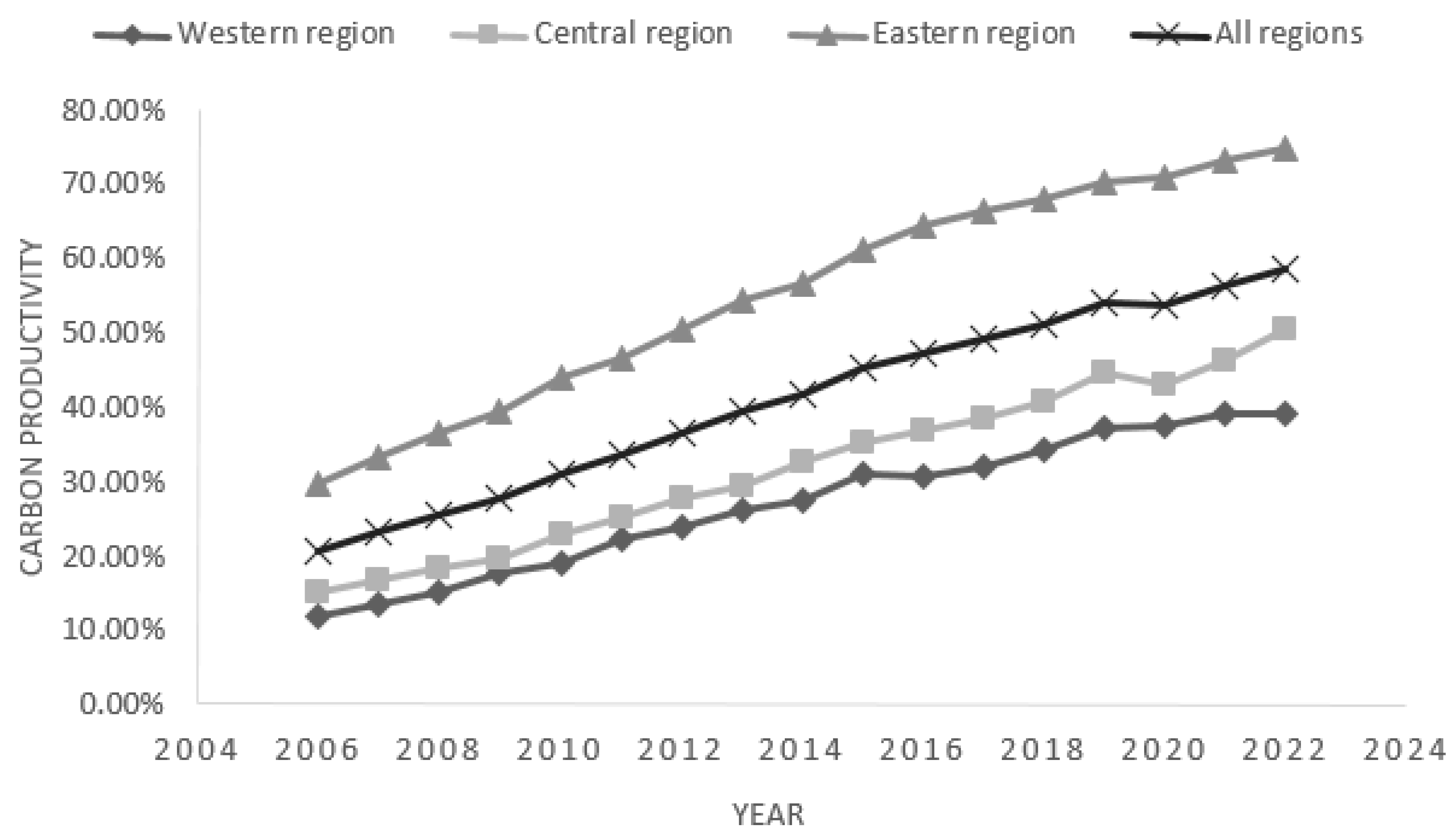
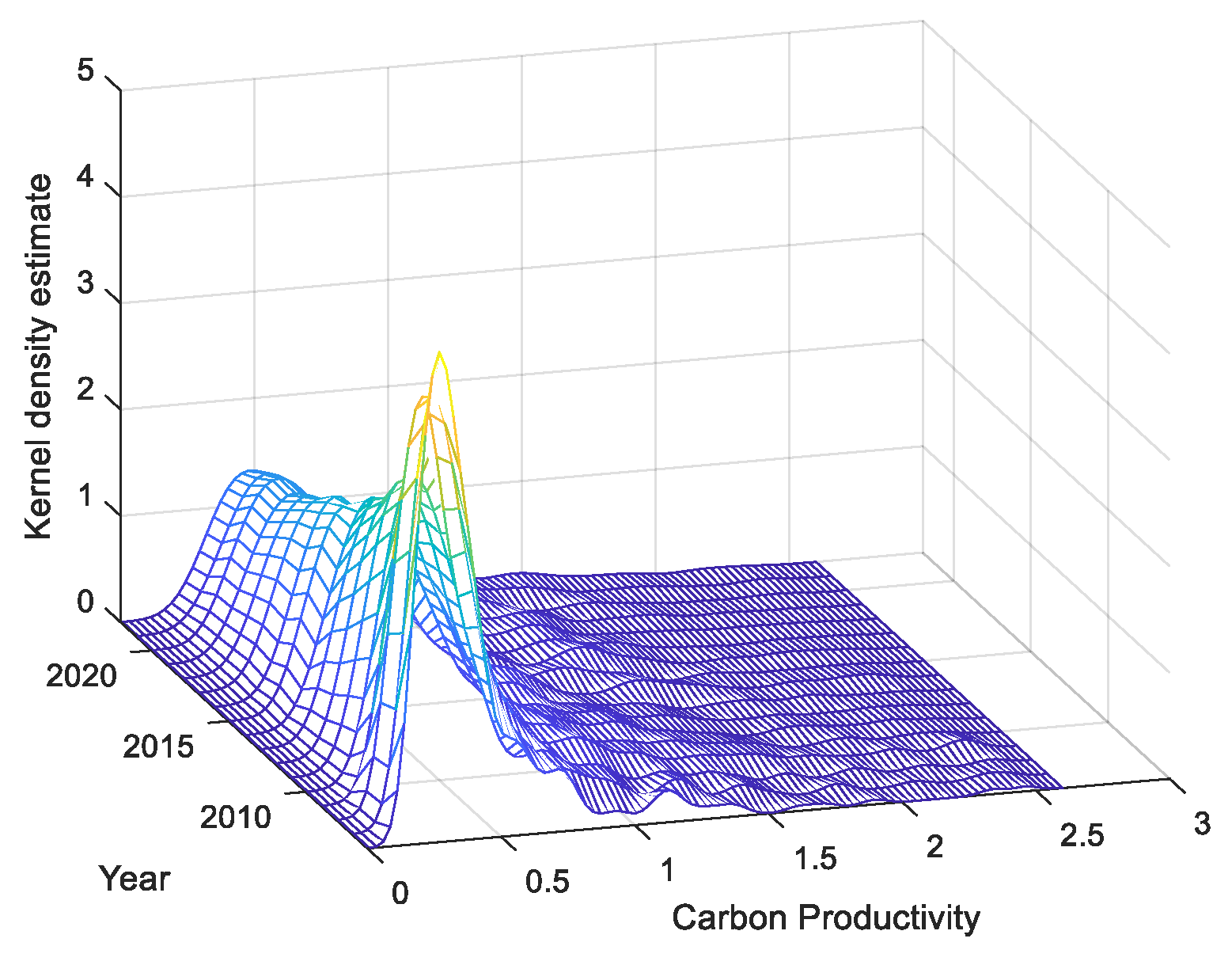
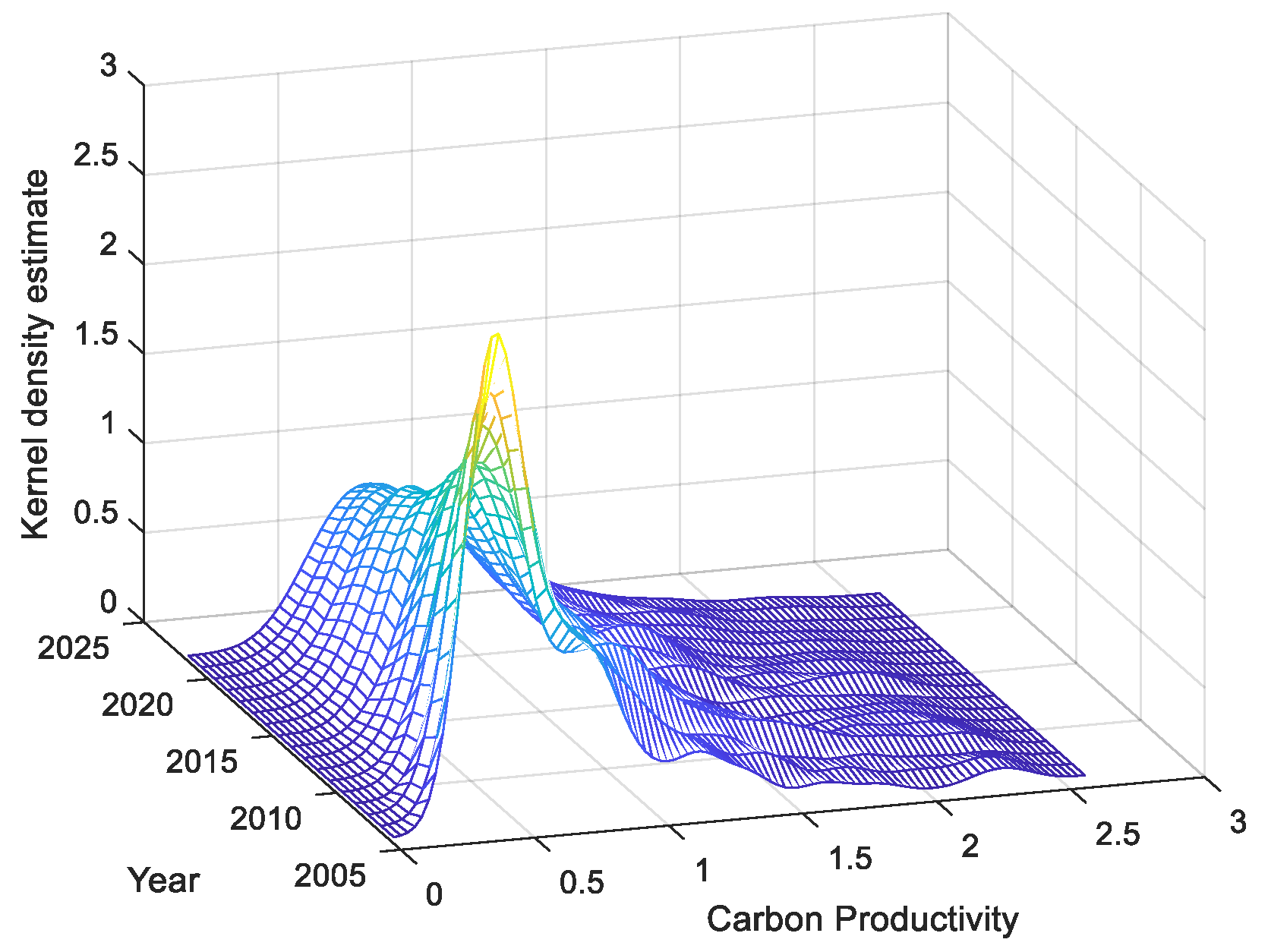
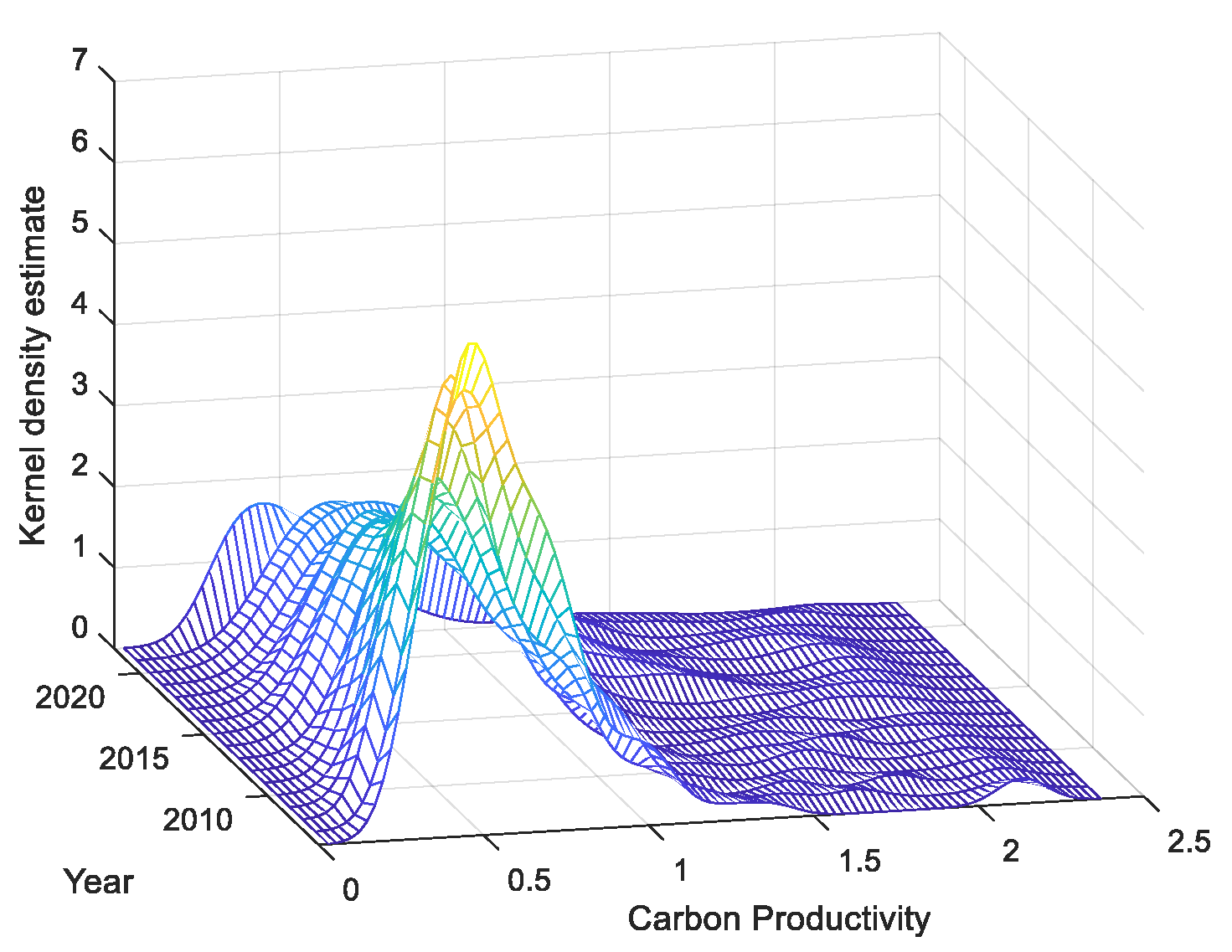

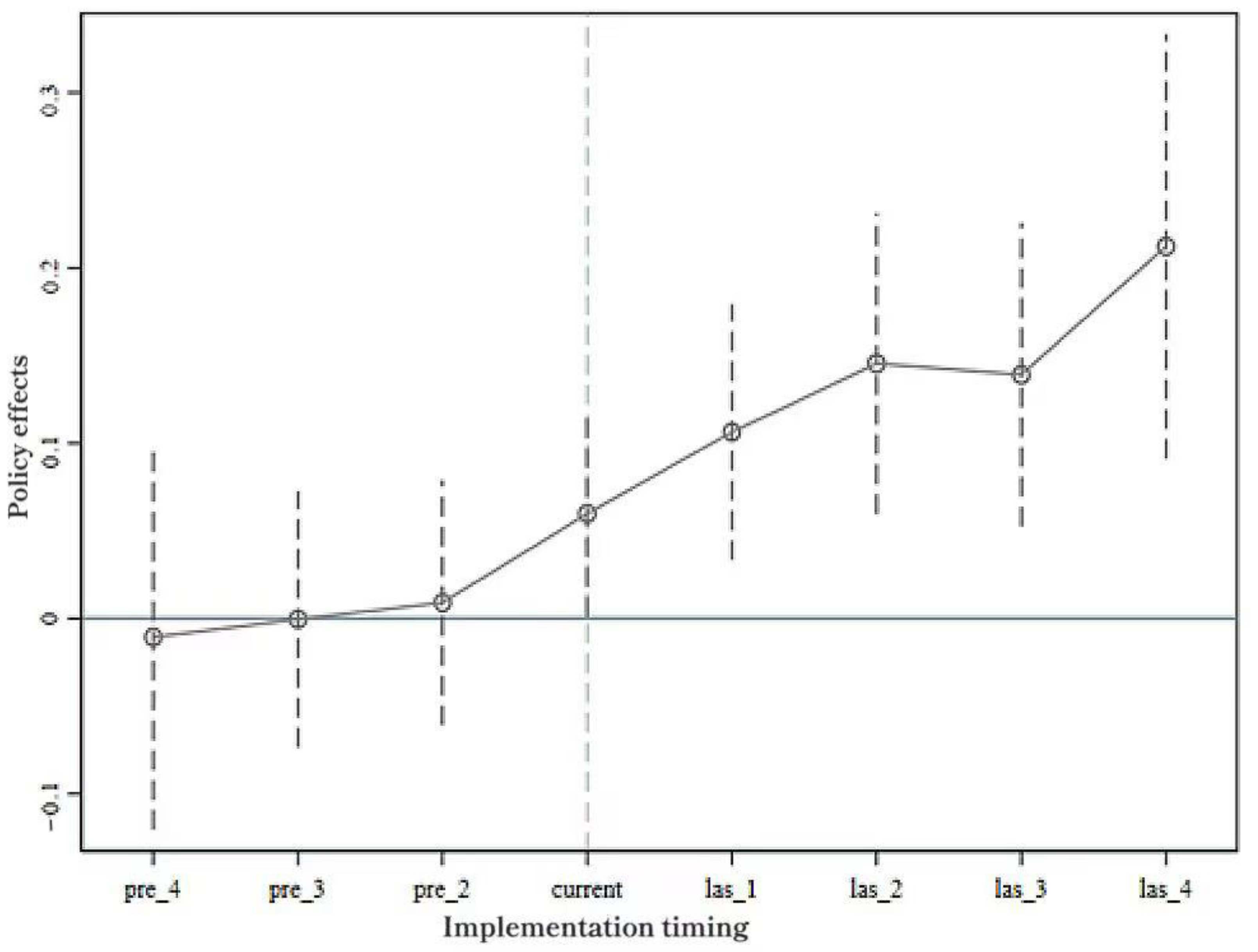

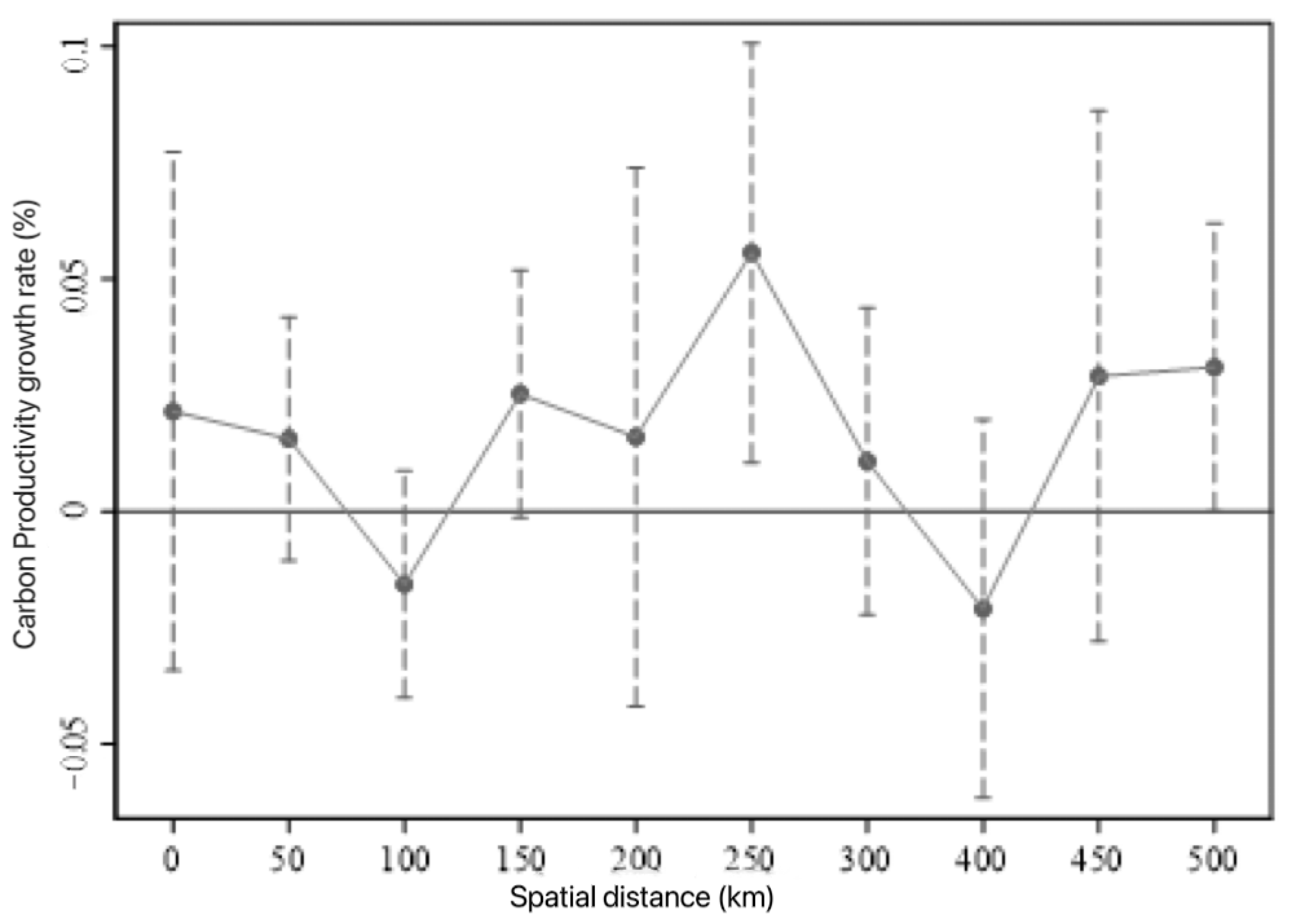
| Indicator | Secondary Indicator | Tertiary Indicator |
|---|---|---|
| Input | Labor | Number of employees in each prefecture-level city, in tens of thousands. |
| Capital | Using the perpetual inventory method, the capital stock is represented as follows: , where denotes the material capital stock (RMB ten thousand) of city in year , and represents the economic depreciation rate. In this study, the depreciation rate was set at 9.6%, based on the findings of Zhang et al. [21]. represents the total fixed asset formation (i.e., capital flow, in RMB ten thousand) of city in year , adjusted to constant 2006 prices. | |
| Energy | Direct energy consumption (e.g., natural gas and liquefied petroleum gas) and indirect energy (e.g., electricity) are converted to standard coal using conversion factors, as outlined in the General Principles of Comprehensive Energy Consumption Calculation—, , and , respectively—to resolve the unit inconsistency. | |
| Expected Output | Urban GDP | GDP is calculated using 2006 price levels as the base year to eliminate the influence of price changes in subsequent years. |
| Undesirable Output | Urban Carbon Emissions | The urban carbon emission accounting in this study covers four main emission sources: direct energy consumption, electricity, transportation, and thermal energy, as detailed in Section 2.2.1 above. |
| (1) | (2) | (3) | |
|---|---|---|---|
| DID | 0.832 *** | 0.304 *** | 0.233 *** |
| (6.421) | (4.223) | (3.685) | |
| FIE | −0.022 *** | ||
| (−3.169) | |||
| CISW | −0.000 | ||
| (−0.760) | |||
| ECO | 0.000 *** | ||
| (7.405) | |||
| AIS | −0.047 | ||
| (−1.326) | |||
| Constant | 0.496 *** | −0.219 *** | −0.212 *** |
| (13.856) | (−8.979) | (−4.311) | |
| Control Variables | No | No | Yes |
| Year Fixed Effects | No | Yes | Yes |
| City Fixed Effects | No | Yes | Yes |
| Observation | 4675 | 4675 | 4675 |
| R2 | 0.122 | 0.858 | 0.876 |
| Variables | PSM-DID | Excluding the Impact of Other Policies | |||||
|---|---|---|---|---|---|---|---|
| Nearest Neighbor Matching | Radius Matching | Smart City Construction | Broadband China Strategy | Big Data Comprehensive Pilot Zone | Excluding the Influence of Municipalities Directly Under the Central Government | Shortening the Sample Period | |
| DID | 0.233 *** | 0.304 *** | 0.199 *** | 0.194 *** | 0.224 *** | 0.196 *** | 0.192 *** |
| (10.12) | (12.32) | (3.253) | (2.853) | (3.660) | (3.183) | (3.750) | |
| DID1 | 0.192 *** | ||||||
| (4.416) | |||||||
| DID2 | 0.117 ** | ||||||
| (1.980) | |||||||
| DID3 | 0.180 *** | ||||||
| (2.833) | |||||||
| Constant Term | 0.150 *** | 0.5833 *** | −0.148 *** | −0.217 *** | −0.211 *** | −0.201 *** | −0.235 *** |
| (4.12) | (94.53) | (−3.066) | (−4.466) | (−4.412) | (−4.198) | (−4.283) | |
| Control Variables | YES | YES | YES | YES | YES | YES | YES |
| Year Fixed Effects | YES | YES | YES | YES | YES | YES | YES |
| City Fixed Effects | YES | YES | YES | YES | YES | YES | YES |
| Observation | 4675 | 4673 | 4675 | 4675 | 4658 | 4607 | 3300 |
| R2 | 0.884 | 0.893 | 0.879 | 0.877 | 0.878 | 0.853 | 0.921 |
| Variables | Large Cities | Medium Cities | Small Cities |
|---|---|---|---|
| DID | 0.377 *** | 0.135 ** | 0.134 |
| (2.962) | (2.104) | (1.403) | |
| Constant | 0.013 | −0.120 | −0.158 |
| (0.104) | (−1.365) | (−1.442) | |
| Control variables | YES | YES | YES |
| City fixed effect | YES | YES | YES |
| Year fixed effect | YES | YES | YES |
| Observation | 2006 | 1683 | 986 |
| R2 | 0.894 | 0.793 | 0.866 |
| Variables | Non-Resource-Based Cities | Resource-Based Cities |
|---|---|---|
| DID | 0.264 *** | 0.140 * |
| (2.795) | (1.786) | |
| Constant | −0.468 *** | −0.099 ** |
| (−5.134) | (−2.247) | |
| Control variables | YES | YES |
| City fixed effect | YES | YES |
| Year fixed effect | YES | YES |
| Observation | 2856 | 1819 |
| R2 | 0.876 | 0.788 |
| Variables | Industrial Structure | Green Patent Innovation Index |
|---|---|---|
| DID | 0.168 *** | 0.448 *** |
| (0.0311) | (4.77) | |
| Constant | 0.331 *** | 1.684 *** |
| (0.0599) | (11.39) | |
| Control variables | YES | YES |
| City fixed effect | YES | YES |
| Year fixed effect | YES | YES |
| Observation | 4675 | 4675 |
| R2 | 0.334 | 0.625 |
Disclaimer/Publisher’s Note: The statements, opinions and data contained in all publications are solely those of the individual author(s) and contributor(s) and not of MDPI and/or the editor(s). MDPI and/or the editor(s) disclaim responsibility for any injury to people or property resulting from any ideas, methods, instructions or products referred to in the content. |
© 2025 by the authors. Licensee MDPI, Basel, Switzerland. This article is an open access article distributed under the terms and conditions of the Creative Commons Attribution (CC BY) license (https://creativecommons.org/licenses/by/4.0/).
Share and Cite
Deng, G.; Qian, J. How Does the Pilot Information Consumption Policy Affect Urban Carbon Productivity? Quasi-Experimental Evidence from 275 Chinese Cities. Sustainability 2025, 17, 4266. https://doi.org/10.3390/su17104266
Deng G, Qian J. How Does the Pilot Information Consumption Policy Affect Urban Carbon Productivity? Quasi-Experimental Evidence from 275 Chinese Cities. Sustainability. 2025; 17(10):4266. https://doi.org/10.3390/su17104266
Chicago/Turabian StyleDeng, Guangyao, and Jiao Qian. 2025. "How Does the Pilot Information Consumption Policy Affect Urban Carbon Productivity? Quasi-Experimental Evidence from 275 Chinese Cities" Sustainability 17, no. 10: 4266. https://doi.org/10.3390/su17104266
APA StyleDeng, G., & Qian, J. (2025). How Does the Pilot Information Consumption Policy Affect Urban Carbon Productivity? Quasi-Experimental Evidence from 275 Chinese Cities. Sustainability, 17(10), 4266. https://doi.org/10.3390/su17104266






